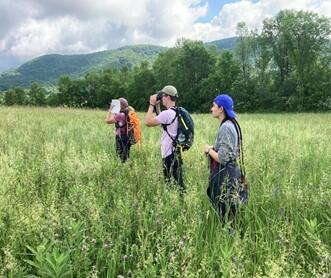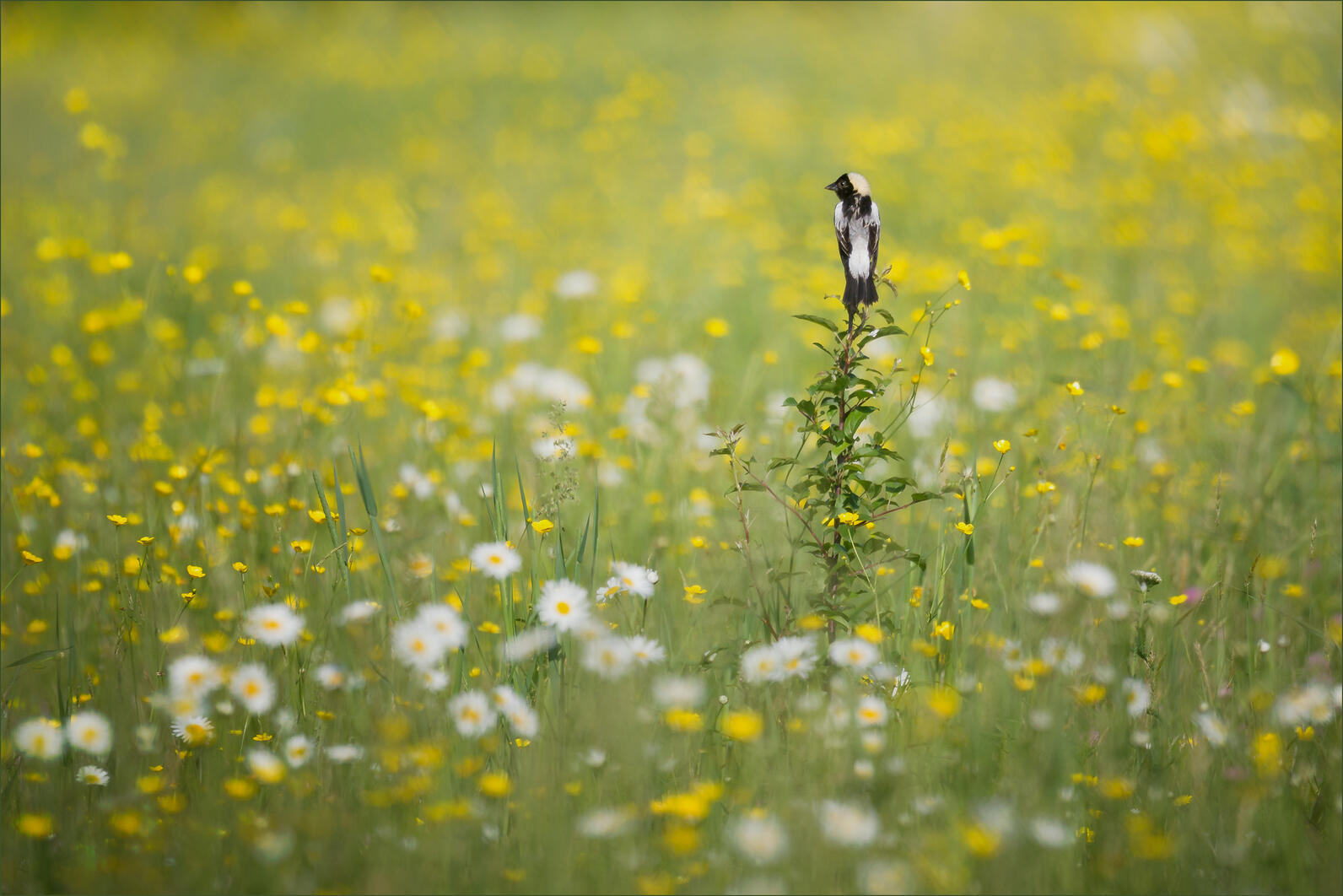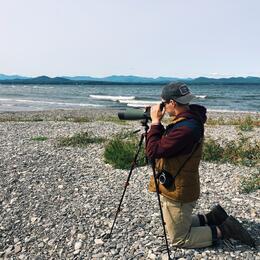Audubon Vermont hosts paid conservation, education, and policy interns every semester. Their writing provides an intern's-eye view of the exciting and important work being done by Audubon Vermont every day. Tyler Philbrook was one of Audubon Vermont's Conservation Interns for the summer of 2021. Check out our alumni page for more information and stories!
6,000 miles. At the end of the breeding season in late August, a Bobolink takes off from a field in Addison County to head south. 6,000 miles is how far the charismatic R2-D2-sounding birds migrate from breeding to wintering grounds in South America. (To take a look at the travel routes of this year’s tagged Bobolinks: click here. You can also see abundance of animations over the course of the year here.)
This summer I worked as an intern for Audubon Vermont and I participated with the Bobolink Project. It was then that I saw exactly what Bobolinks represent to conservation and humanity’s relationship with wildlife.
I attended the University of Vermont, where Bobolinks were discussed in wildlife classes through whispers of conservation and described as an icon of potential success between human-wildlife interactions. So, I was surprised to read that Bobolinks are considered a “pest” species in South America due to the significant amounts of valuable grain they consume where they winter. The Bobolink was also known as the “ricebird” due to its tendency to feed on rice fields in the southern U.S. during migration. In South America they also forage on rice paddies and are still considered pests there for this reason.
This begs the question: Why conserve a “pest” species? Well, it’s really all about perspective. Why conserve anything?

Interestingly, most other species in the blackbird family, such as Red-winged Blackbirds and some orioles, only migrate a short distance within the contiguous U.S. or Mexico. Not only are Bobolinks the farthest migrating member of their family, but these neotropical migrants are one of the farthest traveling passerines in North America, with some making a yearly trip of 12,500 miles (20,000 km) round-trip every year.
Most Bobolink migration appears to take place east of the Great Plains. Bobolinks that breed west of the Great Plains fly east first so they can navigate south along the coastline. After the Bobolinks breed, they migrate south where they stop in marshes along the coast to molt before continuing their migration journey. Molting in the marshes allows Bobolinks to maintain new feathers and discard old, weathered ones. Bobolink then travel to Florida and over the Caribbean, stopping on the islands to wait for favorable weather for flying before continuing to South America. There have been multiple sightings of Bobolinks flying over Bermuda, which suggests that many leave well before they reach Florida and fly nonstop to the Caribbean, or even to South America. Interestingly, according to Sibley, Bobolinks use Earth’s magnetic field as their primary navigational guide, along with stars at night.
Northbound spring migrants that cross the Gulf of Mexico are often observed in Louisiana. In talking with Dr. Noah Perlut, director of the Bobolink Odyssey, I learned that ornithologists are using devices called nanotags, essentially geolocating backpacks, to track Bobolink movements. Each Bobolink has the potential to pass nearby multiple massive antennas (called Motus towers), along their migration route. Each time a Bobolink with a nanotag passes by the tower will detect and record the nanotag’s passing.
The nanotags tell researchers that some Vermont Bobolinks have flown south from Vermont toward the coast toward a wildlife refuge in Maryland called Blackwater Refuge. From there, they travel toward the Caribbean Islands, likely stopping there, but other times they may fly straight to South America. From there, Dr. Perlut explains that they may spend a month in Venezuela, a month in Bolivia, then end up somewhere between Bolivia and central Argentina, and possibly Peru too. While in their wintering grounds, they inhabit rice paddy fields, feeding on the rice. Unfortunately, the rice fields are treated with pesticides by farmers who are trying to protect their crops from the Bobolinks. Specifically, farmers have been observed targeting Bobolinks in Bolivia with toxic pesticides. As an alternative farming management practice, Dr. Rosalind Renfrew in a 2017 paper has suggested farmers could alot a field as the “Bobolink field” - a field that they would not treat with pesticide and where, hopefully, Bobolinks would funnel to
Additionally, an alarming study this year suggests that grassland songbirds may not be adapting to climate change as successfully as agriculture is. With climate change, many of the environmental cues that birds use to migrate have become unreliable. The degree to which climate change affects a species will depend on their reliance on phenological cues, according to recent research from Dr. Maeve McGowan. An example of a phenological event would be the timing of when a plant flowers; it is a biologically recurring event that is dependent on climate. Dr. McGowan suggests that long-distance migratory birds, like Bobolinks, may not be as adaptable to these constant phenological changes as short-distance migrants due to the distance between breeding and wintering grounds. Short-distance migrants may be able to adapt more successfully to phenological changes because of the similarity in climate between breeding and wintering grounds. Long-distance migrants will likely struggle more to adjust the timing of their migration as they travel between climates like Vermont and Argentina where climate change impacts will be drastically different.
Making matters even more difficult for Bobolinks are the unreliable patterns of grassland bird migration. Dr. Perlut told me that after a field was hayed on Shelburne Farms in Vermont this past year, tagged Bobolinks relocated to another field for an entire month before migrating. He also mentioned how some birds this year flew hundreds of miles north before heading south to wintering grounds. Grassland birds’ reliance on agricultural fields makes the group more susceptible than some other groups because they must contend with climate change affecting their migration as well as the shifts in agricultural practices on both wintering and breeding grounds. Agriculture in Vermont has diminished over the past 50 years and many former dairy hayfields are now owned by landowners who don’t mow them on the same schedule as farmers. Dairy farmers have also been haying earlier in the spring and more frequently throughout the summer, usually three times per year. Bobolink populations are predicted to decline by 50% in the next 48 years due to the many pressures facing their habitat, according to Dr. Rosalind Renfrew.

One program is attempting to alleviate some of this pressure. The Bobolink Project uses donated funds to pay farmers and landowners to delay their mowing for a few months so Bobolinks can breed in their grassy fields. If you’d like to become a part of this project you can donate to the Bobolink Project here. The mission of the Bobolink Project is so vital and involves actions that individuals can take. It has the potential to save thousands of Bobolinks and to combat the larger, macro-problem that is climate change.
It’s been a summer of Bobolinks. The work with Audubon and Bobolinks has shown me what pure generosity looks like. There’s a lot of hope to be found in conservation and its supporters. The folks donating money to the Bobolink Project are receiving nothing beyond the knowledge that they’re aiding in keeping a species alive - but that’s all they need. It’s a beautiful prospect really - generosity. Lost in the madness of the summer fieldwork, the changing climate, and the constant buzz of society, are the reasons why conservation is so vital and just how kind the world can be.





